全文HTML
--> --> -->直观的实验观测是研究RBM效应的一种重要方法, 其中纹影法[17,18]、阴影法[19]以及干涉法[20]为非介入式可视化实验观测方法, 对实验对象的流动及传质过程没有影响, 因而被广泛应用于RBM效应的实验研究. Okhotsimskii和Hozawa[21]运用纹影技术在多种有机溶剂吸收CO2的过程中观测到向液相主体发展的羽状对流; 王勇和张泽廷[22]与Sun等[23]利用纹影法在平行于界面方向上观察了有机溶剂在水平层流运动过程中吸收CO2的传质过程, 得到了滚筒状和多边形的Rayleigh对流结构; 沙勇等[24]利用阴影法研究丙酮-水溶液解吸CO2传质过程, 在垂直于界面方向上观察到了羽状对流结构. 物质传递过程中RBM效应的研究大多采用气液传质体系, 相较之下, 液-液传质体系的研究还很欠缺. Orell和Westwater[25]利用纹影法研究了乙二醇-乙酸-乙酸乙酯3组分的液-液萃取过程, 观察到了有序的多边形和细胞状对流结构; Zhang等[26]通过纹影法利用水-乙酸-甲苯液-液系统研究了双组分扩散引发的界面湍动现象, 发现只有乙酸浓度高于某一值时才会引发界面湍动; Guzun-Stoica等[27]提出了一种实时动态全息干涉法, 能够直接观察液-液过程中的界面湍动现象, 在研究水-乙酸-乙酸丁酯体系时发现了细胞状对流结构; Kostarev等[28]利用干涉法研究异丙醇水溶液中的氯苯液滴, 观察到细胞状对流结构. 可是这些液-液体系的RBM效应研究都局限于定性地观测界面处的湍动现象, 缺乏对界面湍动的定量化研究, 并且所观察到的现象都是界面对流充分发展后的形态[29,30], 而对于RBM对流由界面向主流发展过程的研究十分匮乏, 对其演化规律也缺乏深入认识.
为此, 本文以水-甲苯-丙酮(溶质)三元体系为研究对象, 基于阴影法建立竖直狭缝内液-液两相液层间传质过程的RBM对流可视化实验平台, 实验观测RBM对流向下层主流区发展过程中出现的典型对流结构, 探索RBM对流向主流区演变发展的规律, 并通过量化主流区流场速度分布、投影图像特征及液-液界面粗糙度, 研究水相、甲苯相丙酮初始浓度以及甲苯液层厚度对RBM对流强度和液-液界面形貌的影响规律.
 图 1 RBM对流的实验系统图 (a) 阴影法实验系统图; (b) 示踪粒子法实验系统图; (c) 玻璃狭缝尺寸图
图 1 RBM对流的实验系统图 (a) 阴影法实验系统图; (b) 示踪粒子法实验系统图; (c) 玻璃狭缝尺寸图Figure1. Schematic diagram of the experimental system for RBM convection: (a) Schematic diagram of the experimental system based on shadowgraph method; (b) schematic diagram of the experimental system based on particle tracer method; (c) size of the glass slit.
此外, 实验中采用粒子示踪法[31]获取详细的流场信息, 实验系统如图1(b)所示. 为此, 下层丙酮水溶液中预先均匀分散质量浓度为0.01%的PSP微球(直径


玻璃狭缝由两块光学玻璃构成, 玻璃两侧和底部用U型硅胶垫片密封, 具体尺寸如图1(c)所示. 玻璃狭缝被竖直安装在三维可移动平台上, 置于点光源与屏幕之间, 调节三者相对距离在屏幕上形成清晰放大的投影图像. 实验时先用注射器向玻璃狭缝中注入一定量的丙酮水溶液, 静置一段时间, 待其界面平稳后, 再用两台LSP01-1BH型注射泵从狭缝两侧同时注入甲苯, 并实时拍摄记录投影屏上的投影图像. 拍摄记录时, CCD拍摄速率设为50帧. 除溶质初始浓度外, 保证其他实验参数一致. 实验环境温度T = 20 ℃, 丙酮水溶液注入量为1.6 mL, 甲苯注液速率均设为0.54 mL/min. 实验前将甲苯与去离子水进行预饱和, 以排除实验过程中这两者之间的传质对溶质扩散传质的影响. 实验中所使用的玻璃狭缝为上部开口结构, 从而使扩散至甲苯中的丙酮可以继续向外界大空间环境中不断挥发, 以保证本实验观测的时间范围内丙酮持续由水向甲苯中扩散传质. 本文将注液开始时刻作为起始时刻. 实验所用分析纯(纯度 ≥ 99.7%)甲苯、分析纯(纯度 ≥ 99.7%)丙酮以及去离子水(纯度 ≥ 99.99%)的具体物性参数见表1. 水-甲苯两相界面张力系数



| 实验试剂 | ρ/kg·m–3 | μ/10–4Pa·s |
| 水 | 998 | 10.04 |
| 甲苯 | 867 | 5.86 |
| 丙酮 | 790 | 3.26 |
表1实验试剂的物性参数(T = 20 ℃, P = 0.1 MPa)
Table1.The physical parameters of experimental reagents (T = 20 ℃, P = 0.1 MPa).
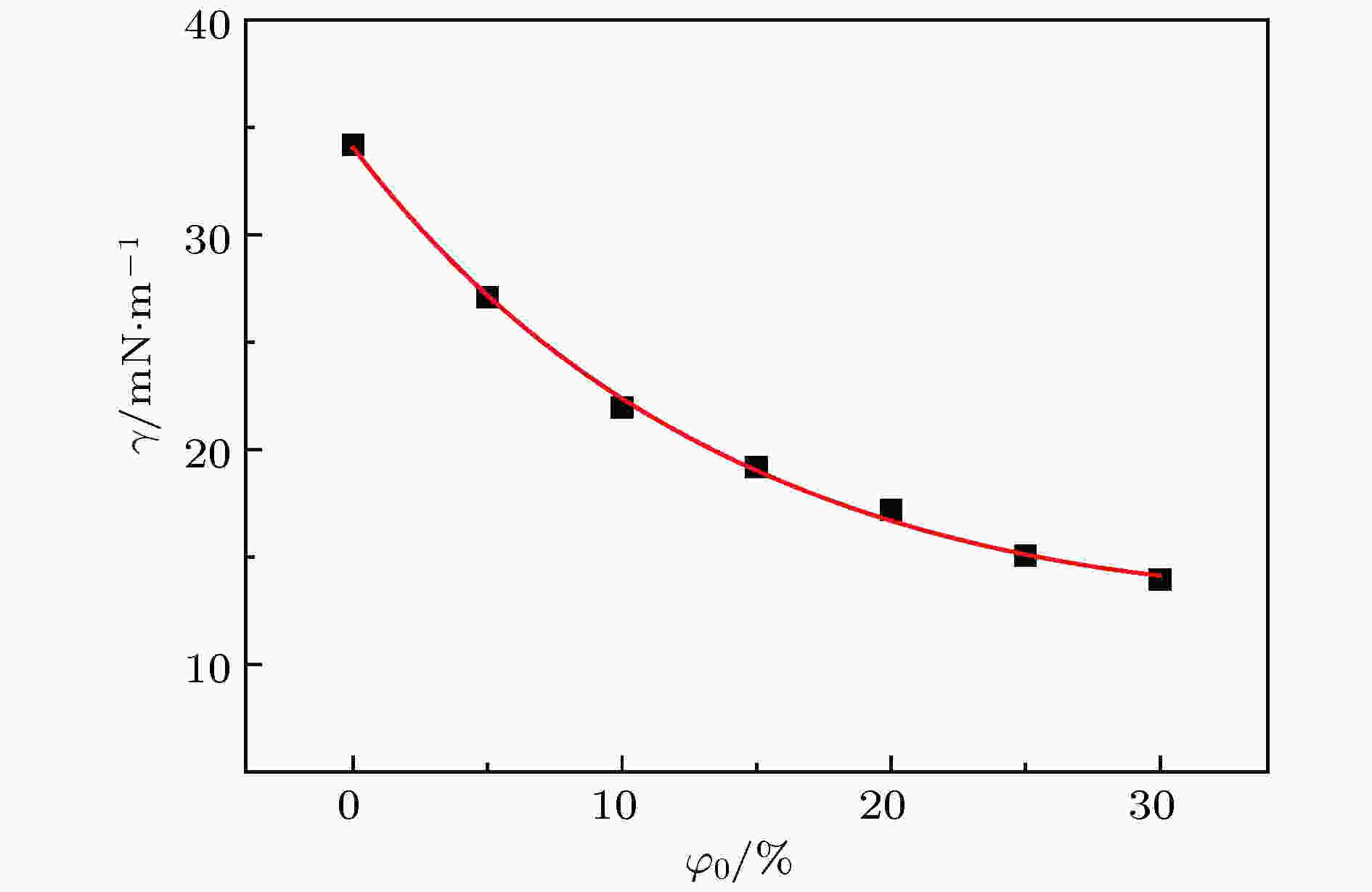 图 2 T = 20 ℃时不同水相丙酮浓度下水-甲苯两相间的界面张力系数
图 2 T = 20 ℃时不同水相丙酮浓度下水-甲苯两相间的界面张力系数Figure2. Interfacial tension coefficient between water and toluene phases under different acetone concentrations of aqueous phase with T = 20 ℃.
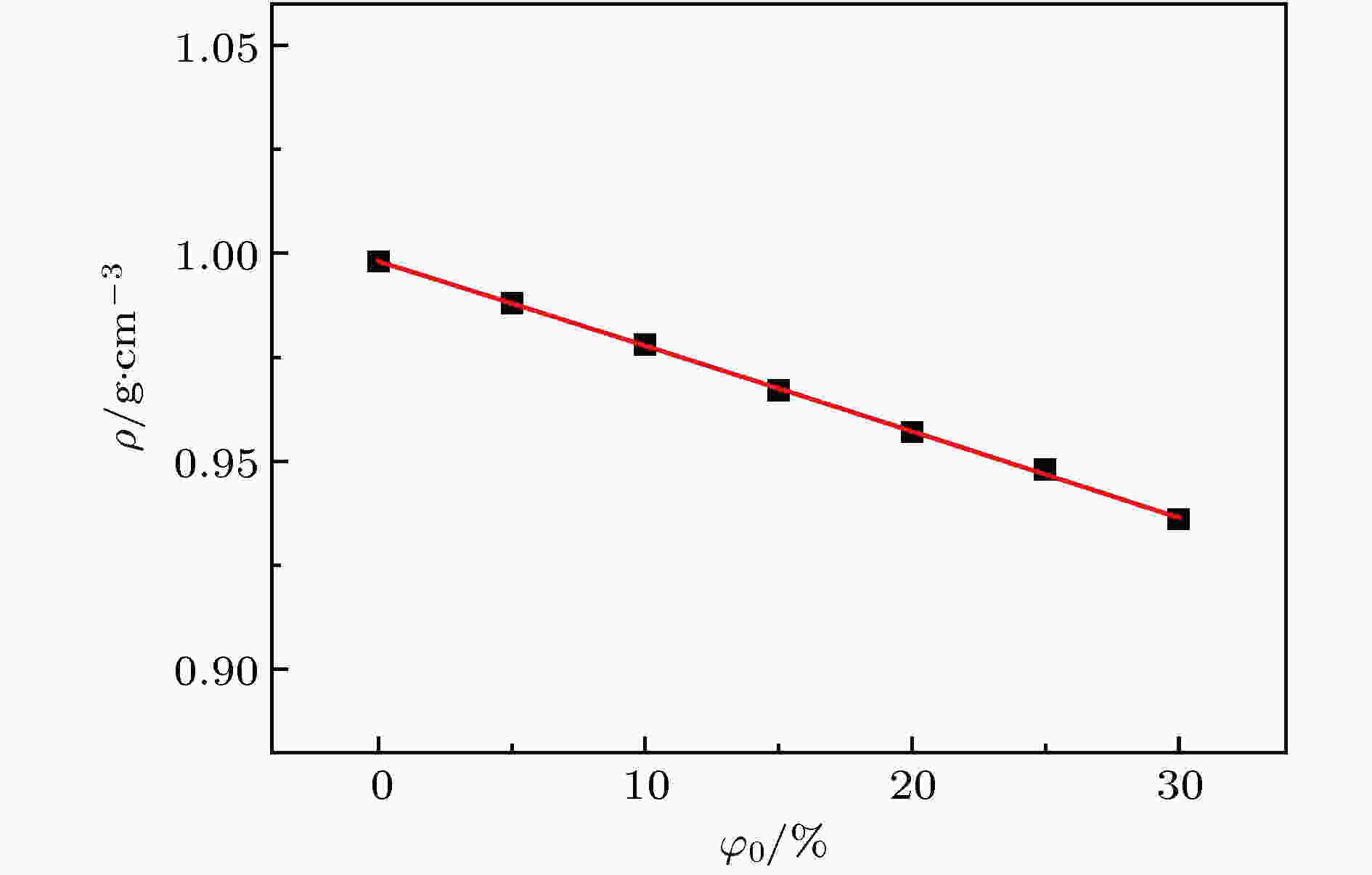 图 3 T = 20 ℃时不同丙酮浓度的水相溶液的密度
图 3 T = 20 ℃时不同丙酮浓度的水相溶液的密度Figure3. Density of aqueous solution with different acetone concentrations with T = 20 ℃.
2
3.1.RBM对流结构分析
考虑到实验中注液带来的扰动以及液层厚度的不断变化将不利于上部液层RBM对流结构的实验观测与定量化分析. 因此, 本文集中对丙酮组分跨界面传质时下层水相溶液中的RBM对流特性进行研究.如图4所示, 随着丙酮向上层甲苯液层扩散传质, 靠近界面处的水相丙酮浓度减小, 并且, 由于扩散过程缓慢, 该处近界面处水相中因扩散传质而损失的丙酮组分得不到来自于下部水相的及时补充. 因此, 传质过程初期水相溶液上部出现了浓度分层的现象, 并且由于丙酮浓度不同造成的折射率差异使得投影图像上近界面处水相上下两层之间产生了一条水相内部“界面”. 而由图3可知, 水相中丙酮浓度的分层必然使其内部产生低密度流体支撑高密度流体的(密度)重力分层现象. 此外, 界面处丙酮传质存在着不可避免的非均匀性, 导致水相内部“界面”处产生不规则的扰动, 如图4(b)所示.
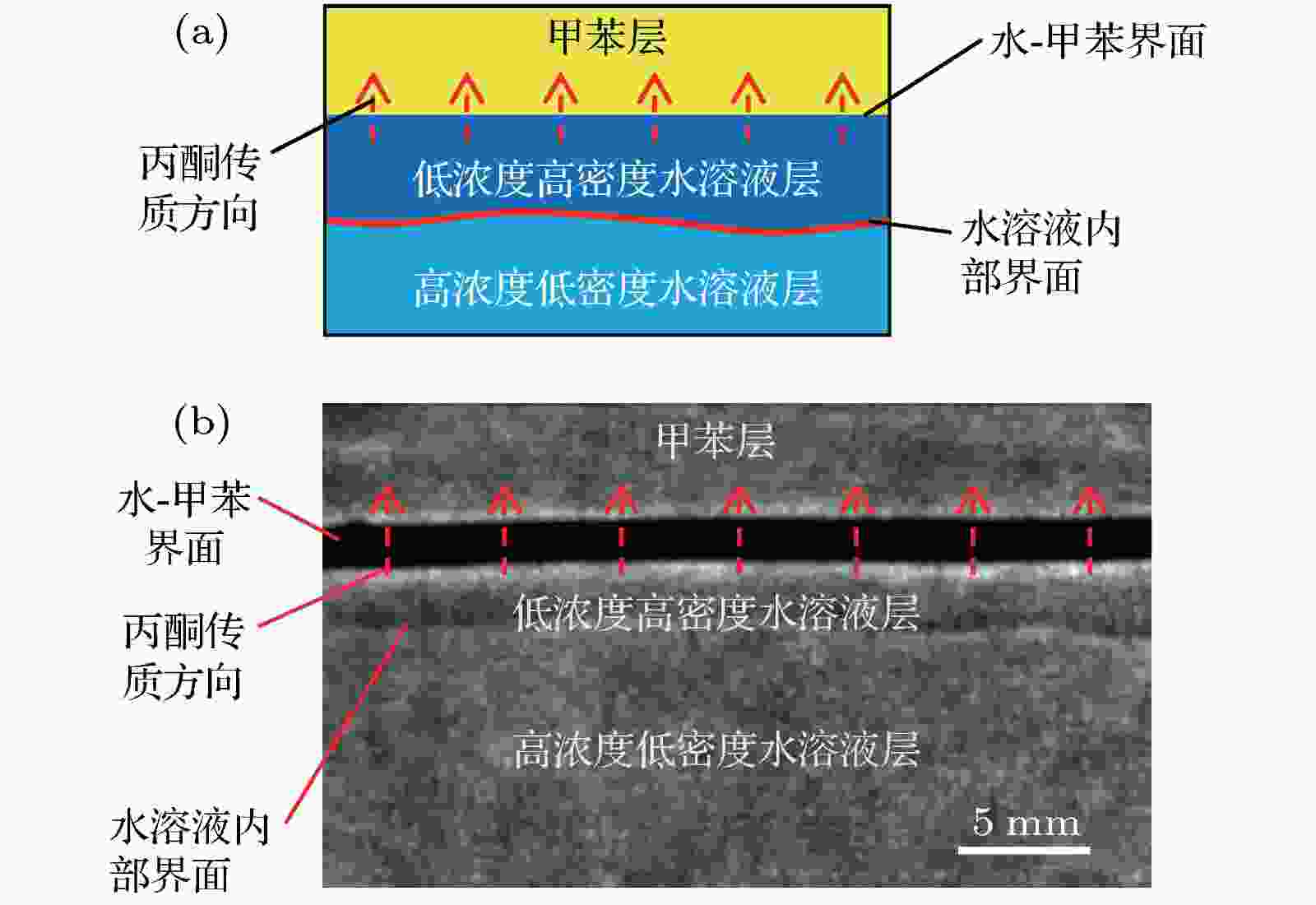 图 4 传质过程引起的密度分层示意图与实验结果 (a) 密度分层示意图; (b) 实验图像
图 4 传质过程引起的密度分层示意图与实验结果 (a) 密度分层示意图; (b) 实验图像Figure4. Schematic diagram and experimental result of density stratification caused by mass transfer: (a) Schematic diagram of density stratification; (b) experimental image.
在这样的条件下, 水溶液内部“界面”上便诱发产生了Rayleigh-Taylor不稳定性[35], “界面”上的扰动单元会造成界面上的密度(重力)梯度与静压梯度失调(界面弯曲造成密度梯度和压力梯度不作用在同一水平线上), 导致上层液体克服流体黏性阻力不均匀地侵入下层液体, 并在界面各处产生斜压转矩而产生涡流[36], 如图5所示. 涡流会使扰动“界面”的凹凸程度不断扩大, 从而使扰动“界面”在下降的过程中呈现出向下凸出的非均匀波浪形丘状“界面”, 如图6所示.
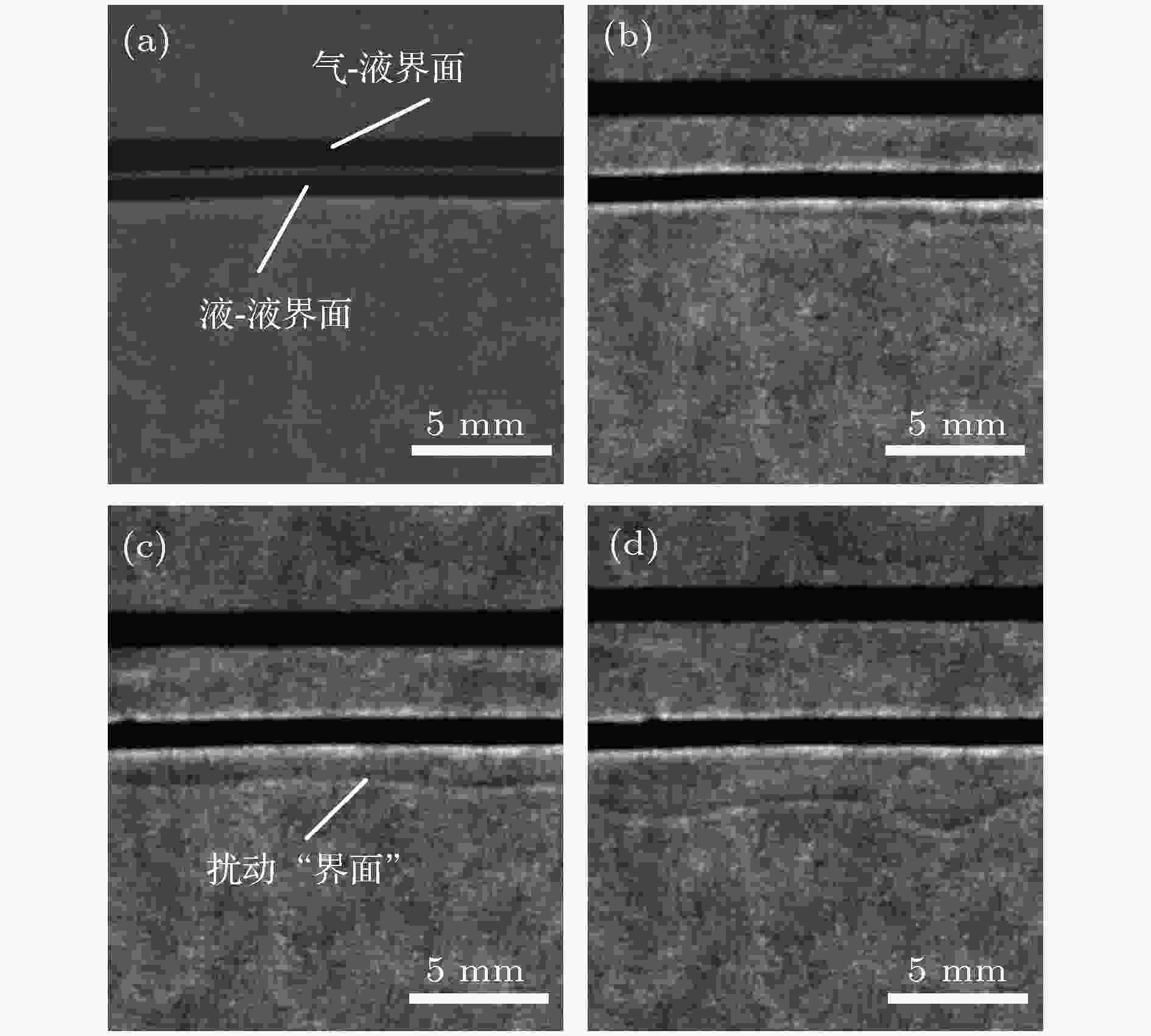 图 6 丘状“界面”的形成过程(水相丙酮初始体积浓度
图 6 丘状“界面”的形成过程(水相丙酮初始体积浓度

Figure6. The forming process of the mound “interface” (the initial volume concentration of acetone in aqueous phase


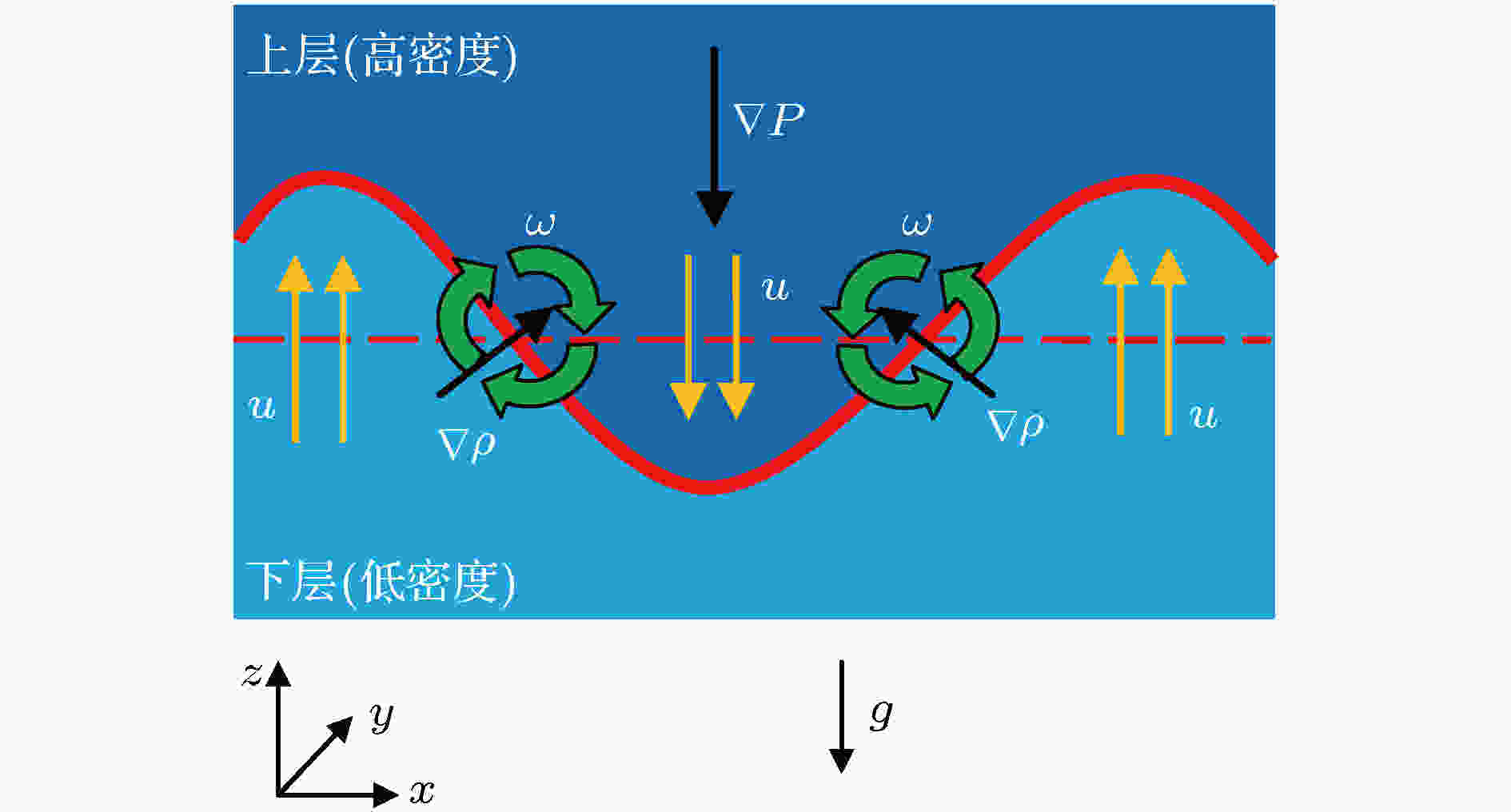 图 5 密度分层引起的Rayleigh-Taylor不稳定性示意图
图 5 密度分层引起的Rayleigh-Taylor不稳定性示意图 

Figure5. Schematic diagram of Rayleigh-Taylor instability caused by density stratification.


随着丘状“界面”结构的不断下移, “界面”处密度梯度与压力梯度失调进一步加剧, “界面”各处涡流强度不断提升, 进而使扰动界面不稳定性进一步加剧, 部分丘状 “界面”下端的前凸幅度进一步增大. 随着时间的推移, 当丘状 “界面”下端前凸处从山丘状演变成柱状时, 羽状流形成(如图7所示).
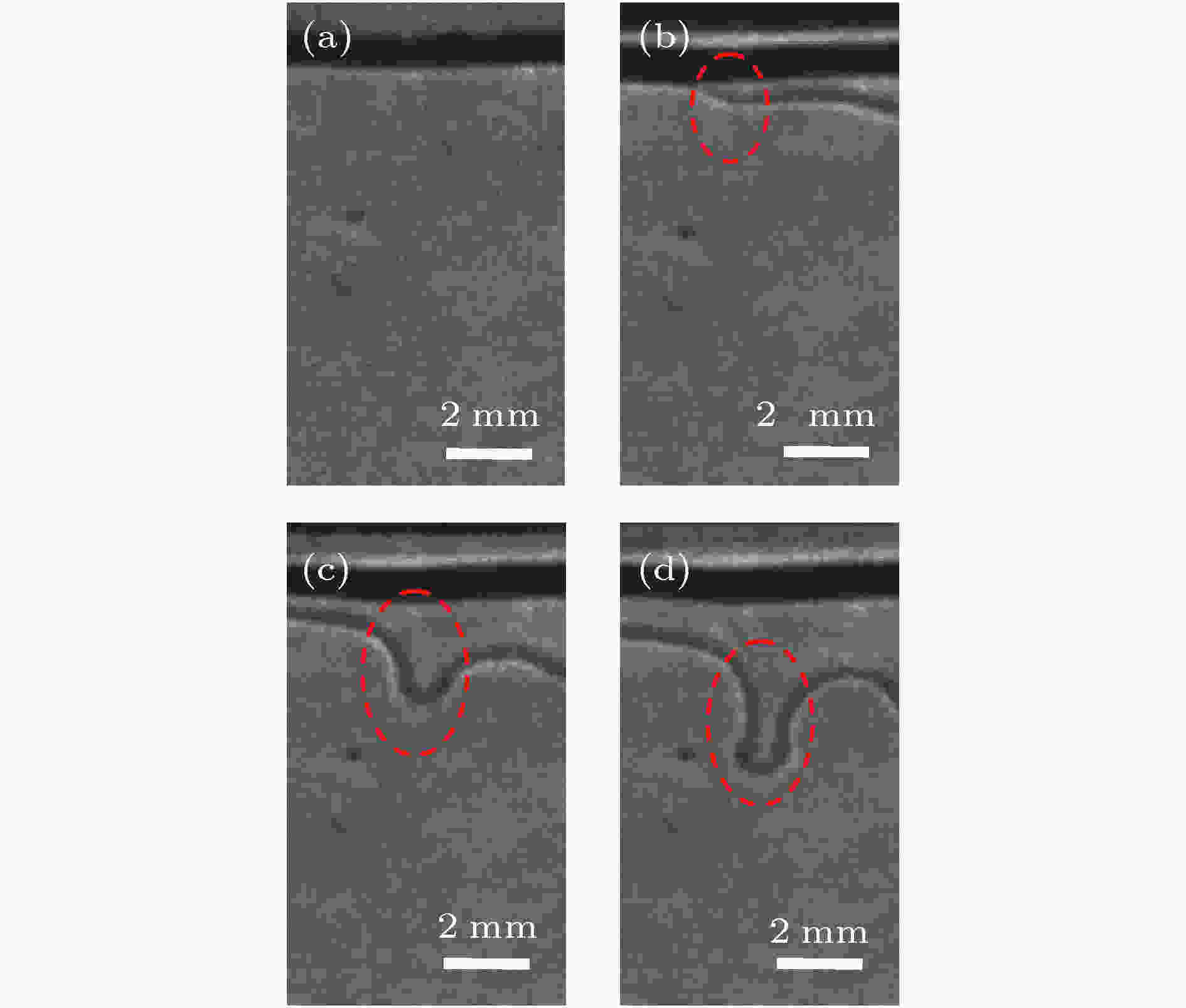 图 7 羽状流的演变过程 (
图 7 羽状流的演变过程 (

Figure7. The evolution of the plume flow (


实验中, 在不同初始丙酮浓度下, 由于密度梯度不同引起的Rayleigh-Taylor不稳定性强度不同, 使得羽状流呈现出弱羽状流和强羽状流两种典型形态. 弱羽状流出现在水相溶液中丙酮浓度比较低的情况(如图8(a), t = 348 s时). 由于此时水相与甲苯相内的丙酮浓度梯度较小, 传质较弱, 其产生的水相液层内竖直密度差较小, 造成Rayleigh-Taylor不稳定性强度较弱, 羽状流向下延伸较慢. 另外, 起初羽状流内外流体的丙酮浓度差异也较小. 因此, 在羽状流缓慢的下降行程中, 羽流区下端流体可与其四周的大空间流体实现充分的传质, 使羽状流下端流体浓度逐渐增大, 直至与其周围主流区流体的丙酮浓度一致. 由于浓度差异消失, 这样由浓度差异导致的液体折射率差异也消失, 这部分羽状流结构会从屏幕上逐渐变浅并最终消失, 从而呈现出颜色由根部向下端逐渐变浅的羽毛状结构, 即弱羽状流, 如图8(d)所示.
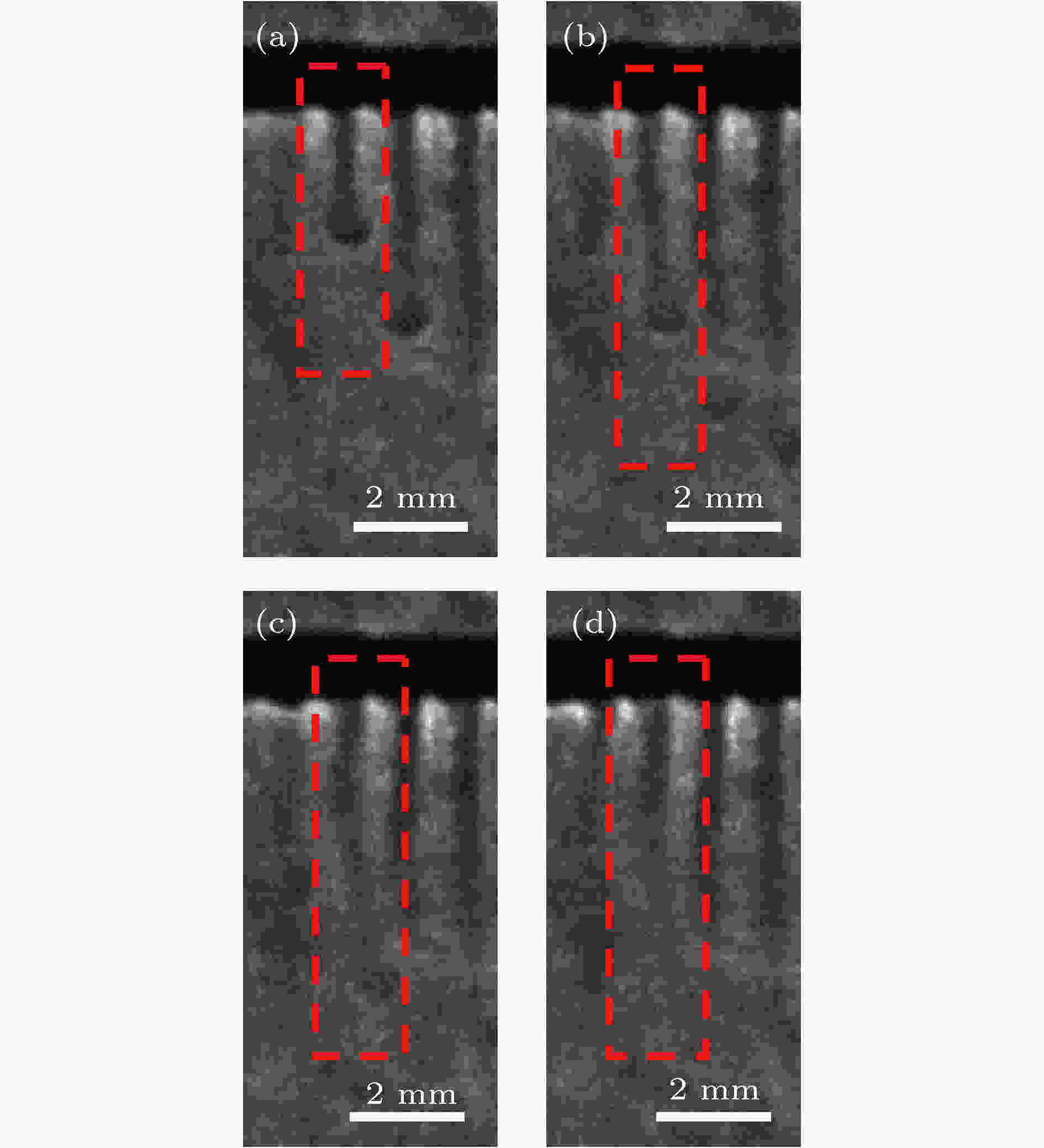 图 8 弱羽状流的演变过程(
图 8 弱羽状流的演变过程(

Figure8. The evolution of the weak plume flow (


为进一步认识羽状流的产生机理, 采用粒子示踪法获取羽状流区域的详细流场信息, 如图9所示. 羽状流区域的流场可划分为羽流区和涡流区两部分. 其中, 涡流区分布在羽流区两侧, 羽流区内流体自上而下运动, 两个涡流区内的流体做涡旋运动且方向相反, 漩涡区内涡量绝对值高于其他区域. 与羽状流的下降速度相比, 涡流区流体流速明显较小, 导致涡流区产生高静压, 羽流区产生低静压, 两者间的压差产生挤压力, 将羽状流颈部压细, 并将流体压向末端. 受到下层相对静止流体的阻碍作用, 快速流向下端的流体流速明显减缓. 这样, 在颈部两侧压差、下层流体阻碍的耦合作用下, 羽状流末端出现体积增大和扁平化的趋势. 特别是(如图10所示), 当水相中丙酮浓度较高时, 羽状流下降快, 导致上述两种效应的耦合作用增强, 使羽状流末端发展成宽扁的弧形帽状, 从而使羽流区整体投影图像呈现出倒蘑菇状(如图10(c), t = 26 s时), 此时, 强羽状流形成.
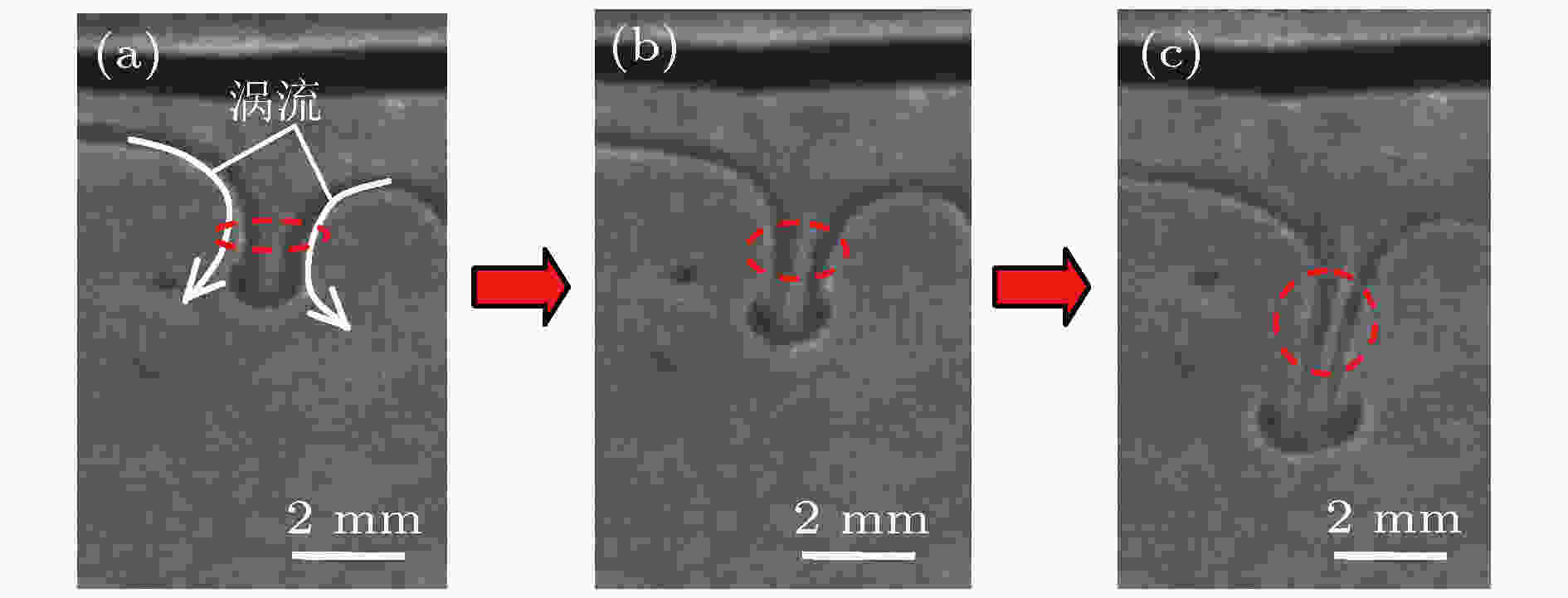 图 10 强羽状流的演变过程(
图 10 强羽状流的演变过程(

Figure10. The evolution of the strong plume flow (


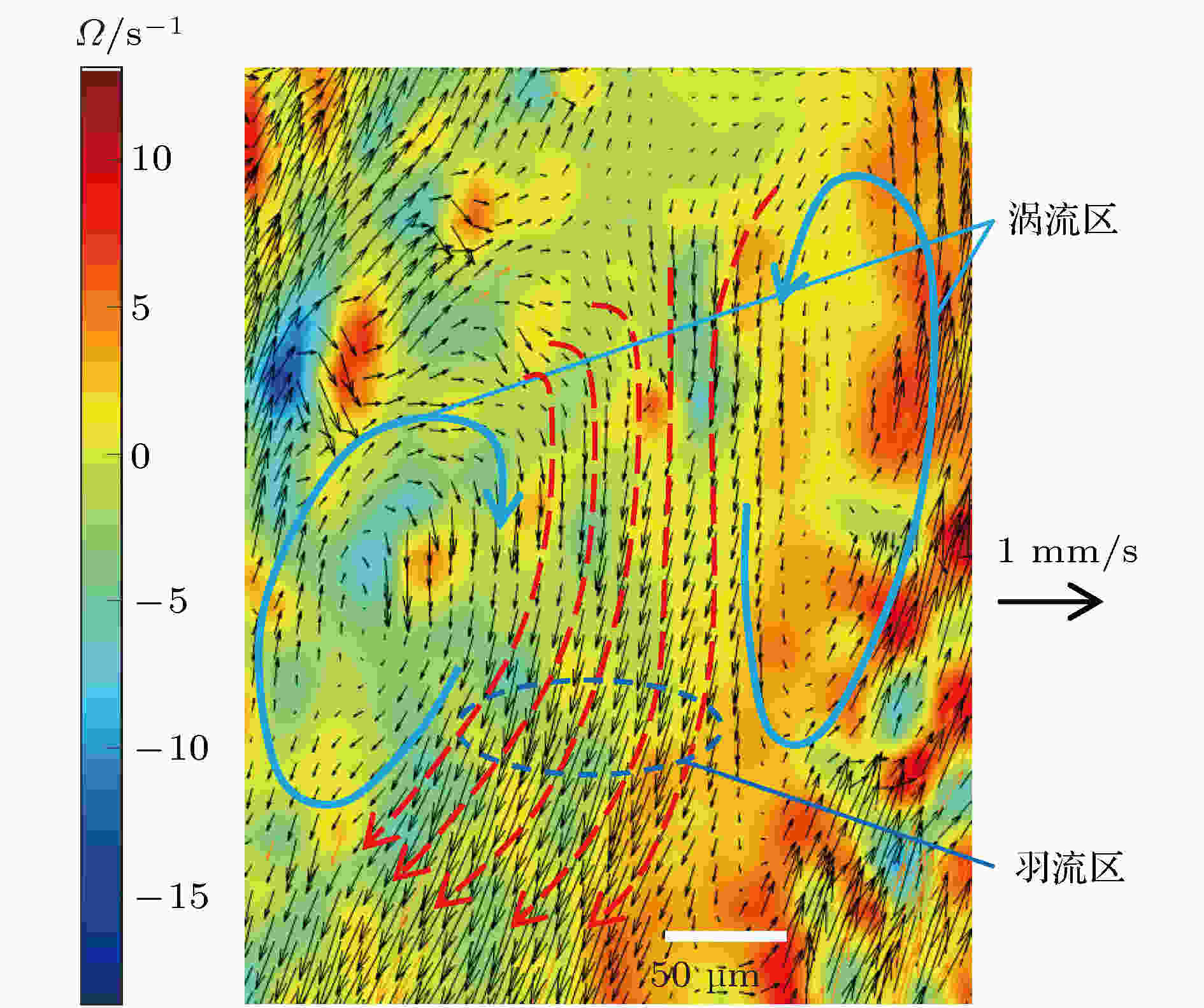 图 9 羽状流的速度矢量及涡量云图(
图 9 羽状流的速度矢量及涡量云图(

Figure9. The velocity vector and vorticity contours of the plume flow (


强羽状流在向下发展过程中, 周边水相内的丙酮组分不断向羽流区进行传质, 导致其内部丙酮组分浓度升高. 因此, 在强羽状流产生的后期, 由于靠近帽状头部的下半部分沉降时间较长, 上述传质过程进行得比较充分, 头部丙酮浓度率先与周边水相内的丙酮浓度趋于一致(折射率趋于一致), 在投影上逐渐消失. 此时, 对流结构从蘑菇云状 变成了羽毛状, 即强羽状流演变为弱羽状流, 如图11 所示.
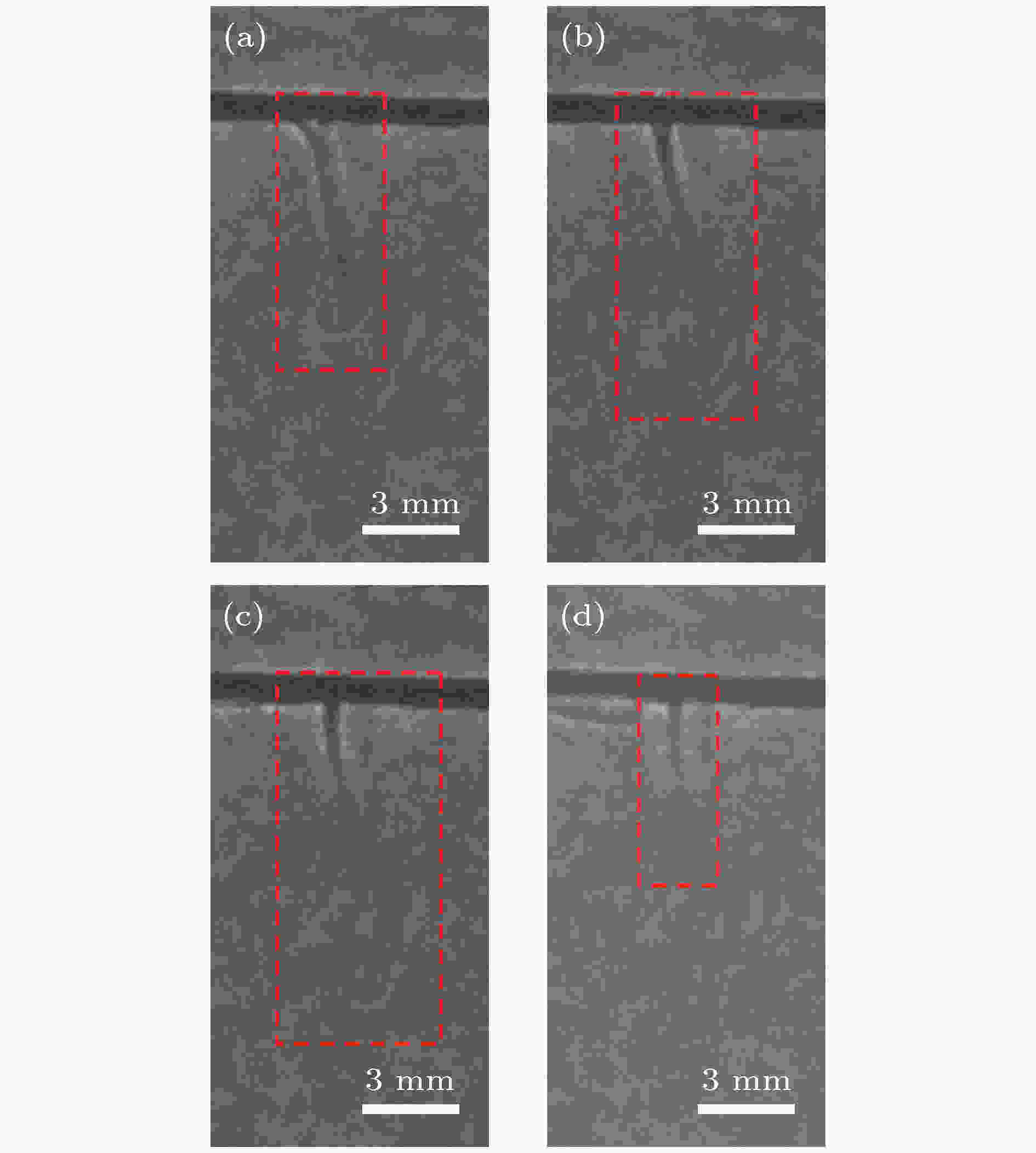 图 11 强羽状流向弱羽状流的演变过程(
图 11 强羽状流向弱羽状流的演变过程(

Figure11. The evolution of the strong plume flow to the weak plume flow (


当丙酮初始浓度梯度较大(如


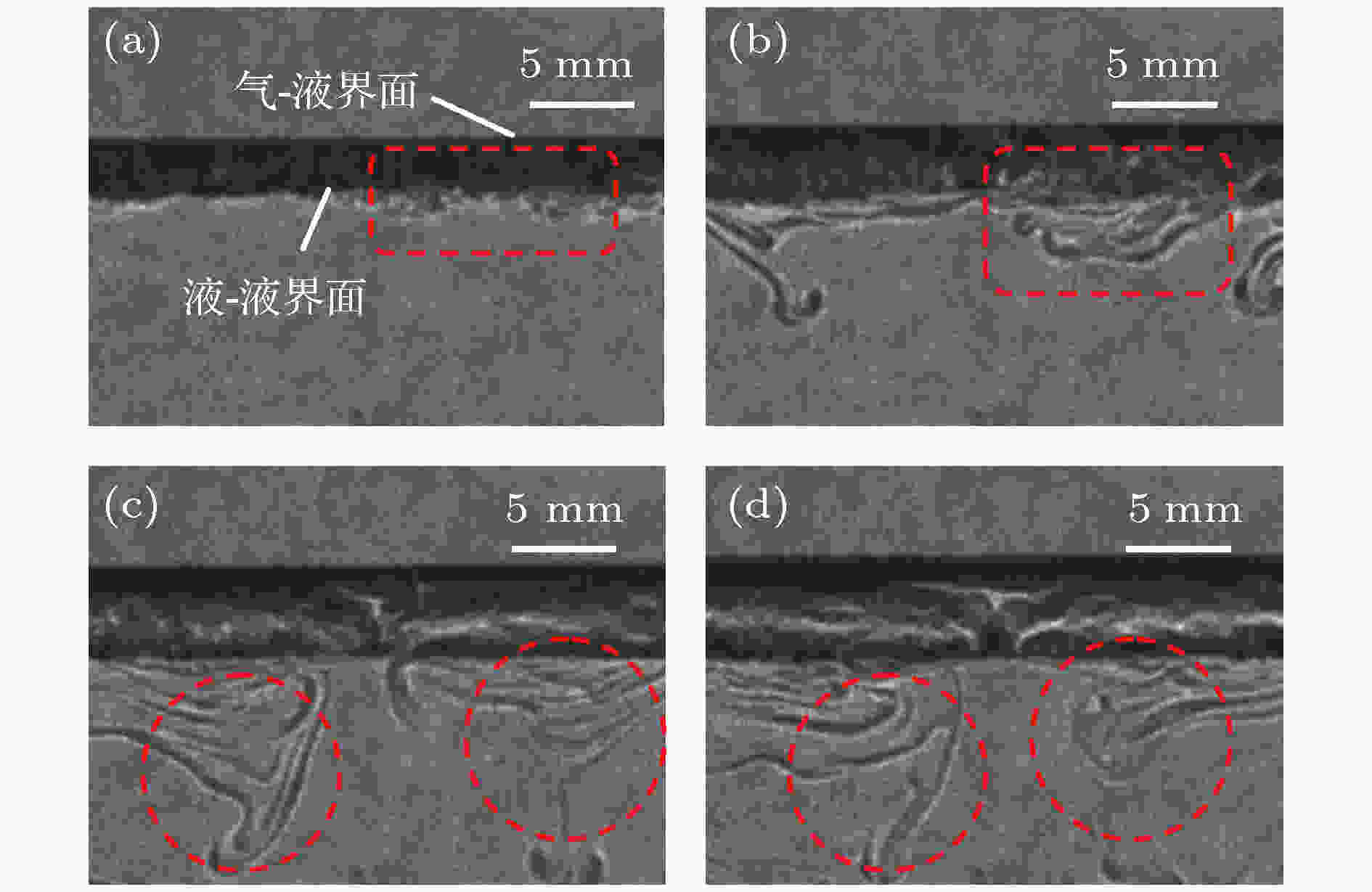 图 12 传质初期对流结构的聚并过程(
图 12 传质初期对流结构的聚并过程(

Figure12. Convergence process of convective structure at the beginning of the mass transfer (


随着传质过程的进行, 水相与甲苯相丙酮浓度梯度逐渐降低, 传质过程减弱, Rayleigh-Taylor不稳定性减弱, 导致界面处产生的对流结构数量减少、间距增大、相互叠加现象逐渐减弱. 这时, 如图13所示, 卷吸对流团的混乱程度降低, 且其体积逐渐变小直到消失, 最终形成独立的羽状流结构(如图13(d), t = 350 s时), 即强羽状流.
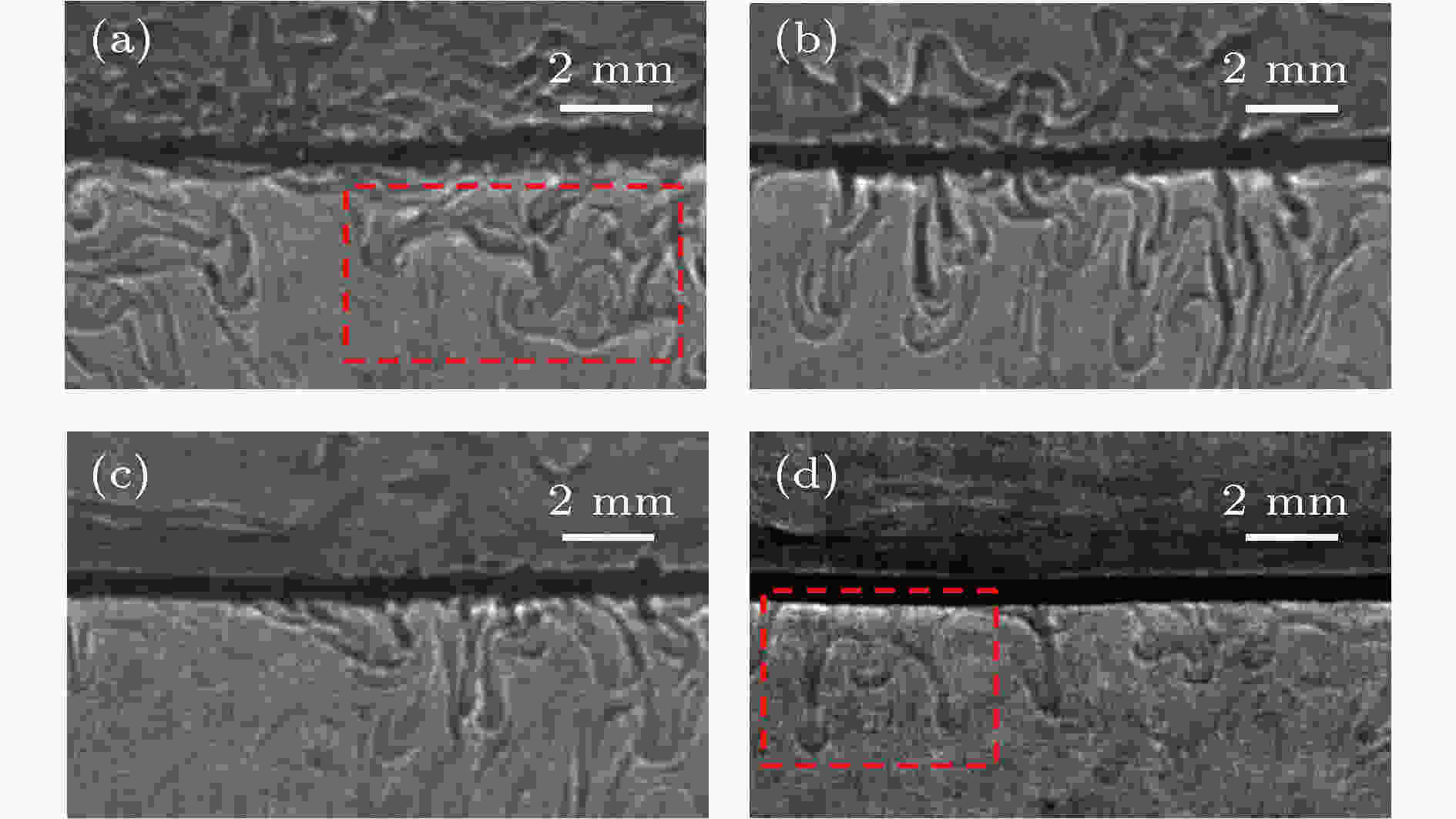 图 13 对流团的消失以及强羽状流的出现(
图 13 对流团的消失以及强羽状流的出现(

Figure13. The disappearance of convective cloud and the appearance of the strong plume (


由此可知, 上述各种RBM对流结构主要是由界面处传质导致的界面张力和密度差异引起的, 同时可随着界面处传质特性的时空变化而呈现出不同的形态并产生相互演化.
2
3.2.水相丙酮初始浓度对RBM对流特性影响
为了探讨溶质初始浓度对RBM对流强度的影响, 本研究借助图像处理手段, 采用对流结构延伸速度v以及羽状流个数n对RBM对流特征进行定量表征. 其中, v定义为第一个RBM对流结构向下延伸的速度, 表征了其向下层主流区发展的快慢; n定义为羽状流的羽流区“枝杈”个数.图14给出了水相丙酮初始浓度对对流结构延伸速度的影响. 如图14所示, 随着水相丙酮初始浓度的增大, 水相与甲苯相丙酮浓度梯度增大, 界面处丙酮传质强度增强, 造成如图4所示的水相近界面处的密度分层现象加剧, 且高、低密度层间“界面”处的扰动增强, 从而诱发了更强的Rayleigh-Taylor不稳定性, 导致水相近界面处上层高密度液体更快地侵入下层低密度液体, 因此, 对流结构向下延伸的速度加快.
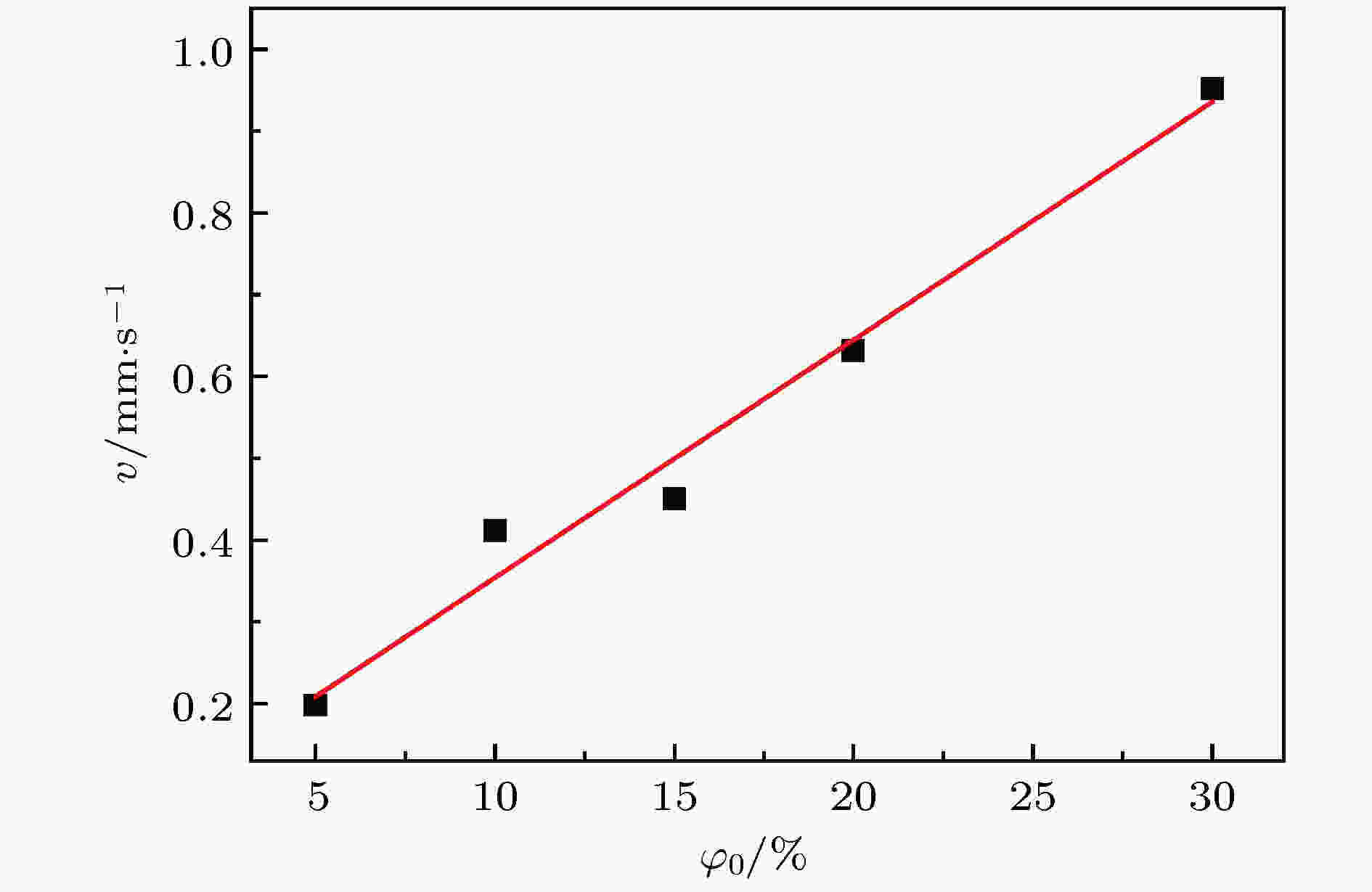 图 14 水相丙酮初始浓度对第一个RBM对流结构向下延伸速度的影响
图 14 水相丙酮初始浓度对第一个RBM对流结构向下延伸速度的影响Figure14. The influence of initial concentration of acetone in aqueous phase on the elongation velocity of the first RBM convective structure.
图15给出了水相丙酮初始浓度对羽状流数量的影响. 由图可知, 随着水相丙酮初始浓度的增加, 初始阶段界面处的传质更为剧烈, 造成水相内近界面处的扰动频率升高[37], 使得羽状流产生的“种子”数量增加, 羽状流数目随之升高; 随着时间的推移, 不同强度的羽状流先后消失-再生-消失, 如此循环便造成羽流区“枝杈”个数出现波动, 并且, 随着丙酮初始浓度的增加, 羽状流消失-再生-消失的演变周期缩短, 使其羽流区“枝杈”数量波动不断增大. 另一方面, 随着羽流区“枝杈”数量的增多, 其相对间距减小, 造成彼此间聚并增强[38]. 因此, 羽流区“枝杈”数量的增幅会随着初始浓度的增大而减小(



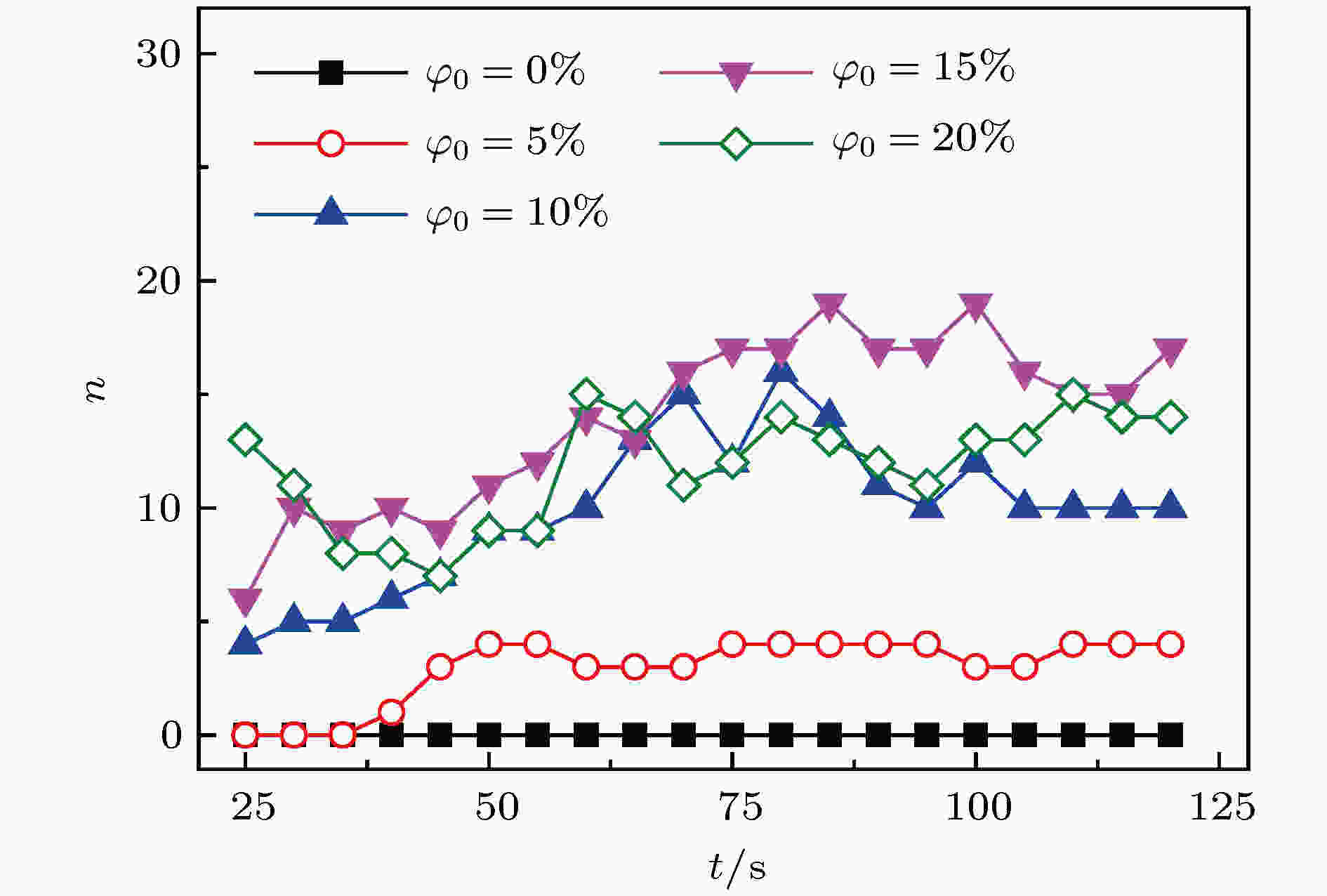 图 15 水相丙酮初始浓度对羽状流数量的影响
图 15 水相丙酮初始浓度对羽状流数量的影响Figure15. The influence of initial concentration of acetone in aqueous phase on the number of the plumes.
此外, RBM对流结构的形成和演变都会造成近界面流场的变化, 从而导致液-液界面形貌产生变化. 因此, 采用界面粗糙度RC [39]定量表征液-液界面形貌



由上述讨论可知, 水相丙酮初始浓度增大时, 由于对流结构数量变多且发展速度加快, 近界面处流场扰动增强, 从而导致不同时刻下的液-液界面变得更加粗糙, 如图16(a)所示. 此外, 同一工况下, 随着时间推移, 对流结构类型和强度不断变化, 导致界面粗糙度也在不断地变化, 从而引起界面波动. 而随着丙酮初始浓度增大, 同一时间段内(如0—400 s)RBM对流结构的种类愈加丰富, 且不同种类之间相互演化行为更为频繁, 造成对流结构形态更为复杂且数量波动变大, 导致界面粗糙度的数值波动会变大, 如图16(b)所示.
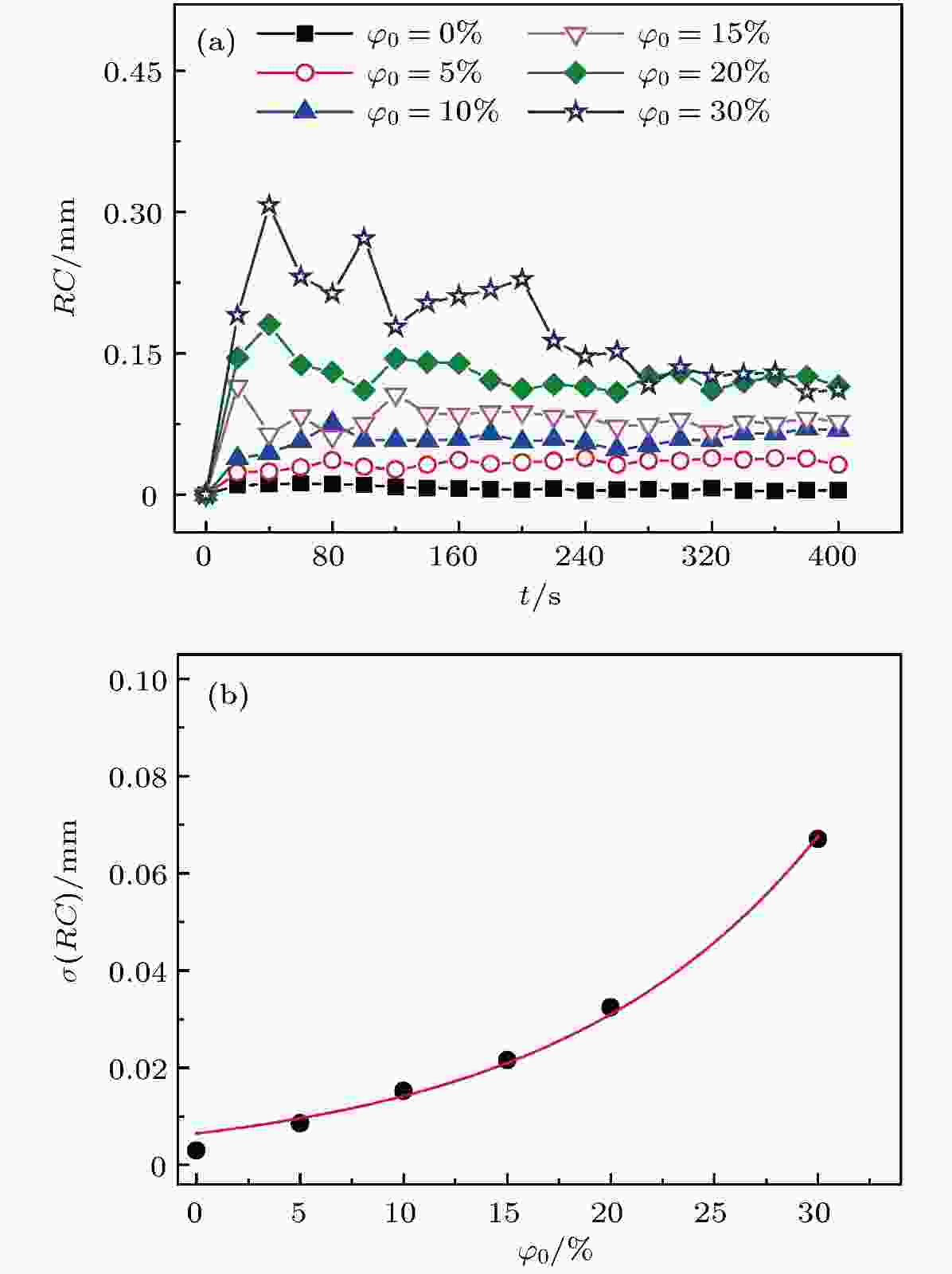 图 16 水相丙酮初始浓度对水-甲苯界面形貌的影响 (a)界面粗糙度; (b)界面波动程度
图 16 水相丙酮初始浓度对水-甲苯界面形貌的影响 (a)界面粗糙度; (b)界面波动程度Figure16. The influence of initial concentration of acetone in aqueous phase on water-toluene interface morphology: (a) Interfacial roughness; (b) the degree of interface fluctuation.
2
3.3.甲苯相丙酮初始浓度对RBM对流特性影响
甲苯相丙酮初始浓度

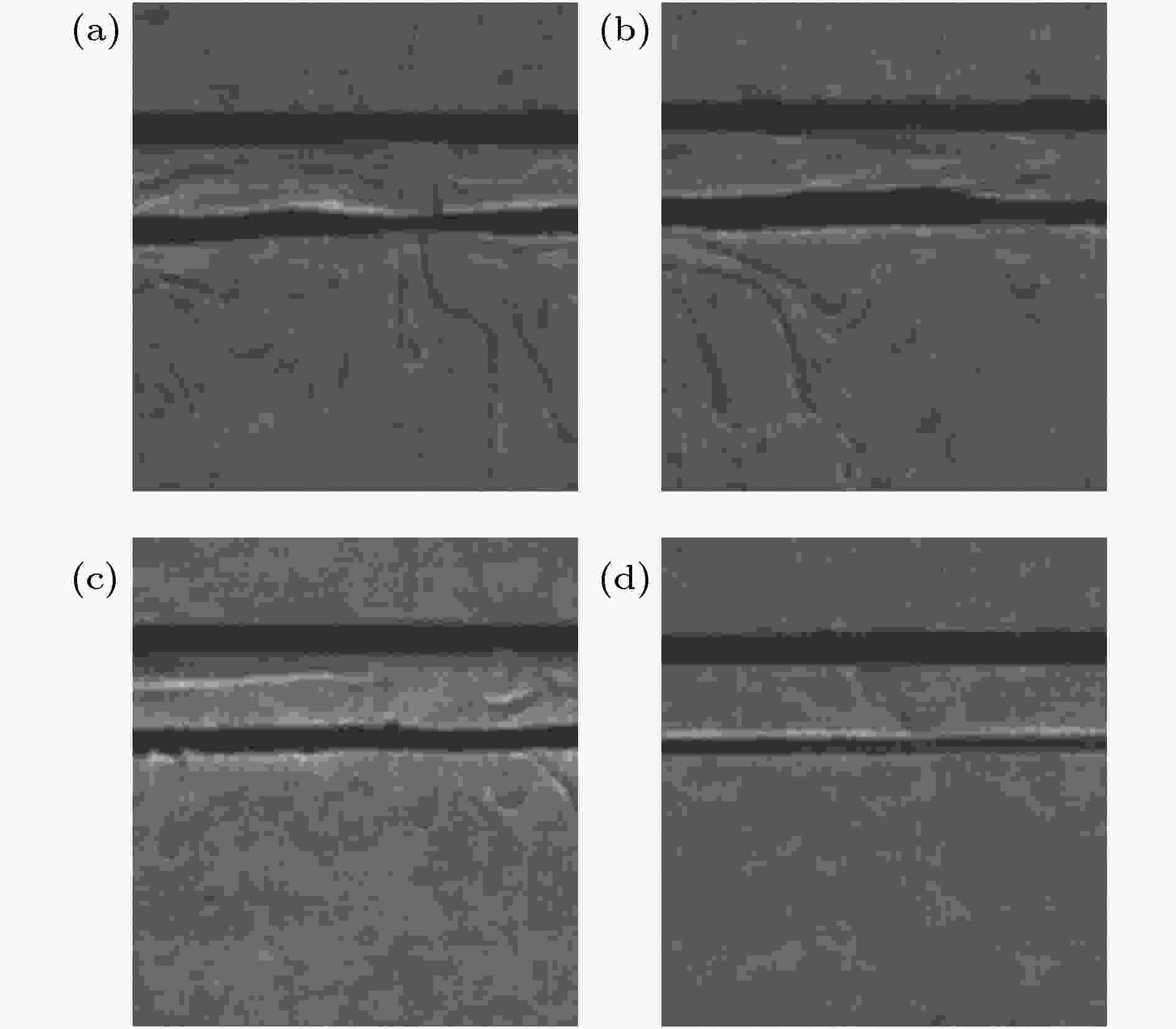 图 17 不同甲苯相丙酮初始浓度下的投影图像(t = 35 s,
图 17 不同甲苯相丙酮初始浓度下的投影图像(t = 35 s, 




Figure17. Schlieren images under different initial concentrations of acetone in the toluene phase (t = 35 s,





为进一步展示甲苯相丙酮初始浓度对RBM对流特性的影响, 图18— 图20分别给出了

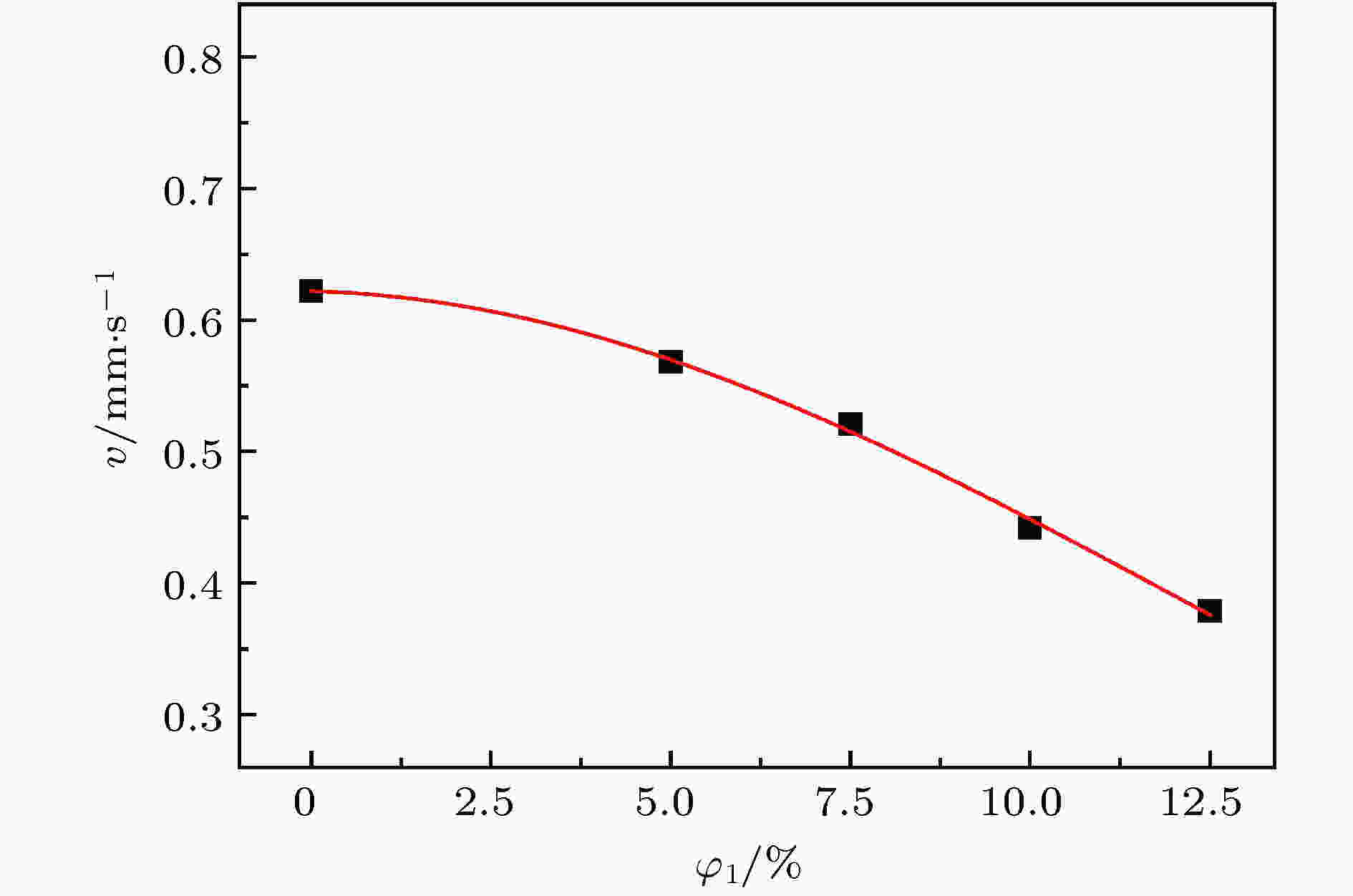 图 18 甲苯相丙酮初始浓度对第一个RBM对流结构向下延伸速度的影响
图 18 甲苯相丙酮初始浓度对第一个RBM对流结构向下延伸速度的影响Figure18. The influence of initial concentration of acetone in the toluene phase on the elongation velocity of the first RBM convective structure.
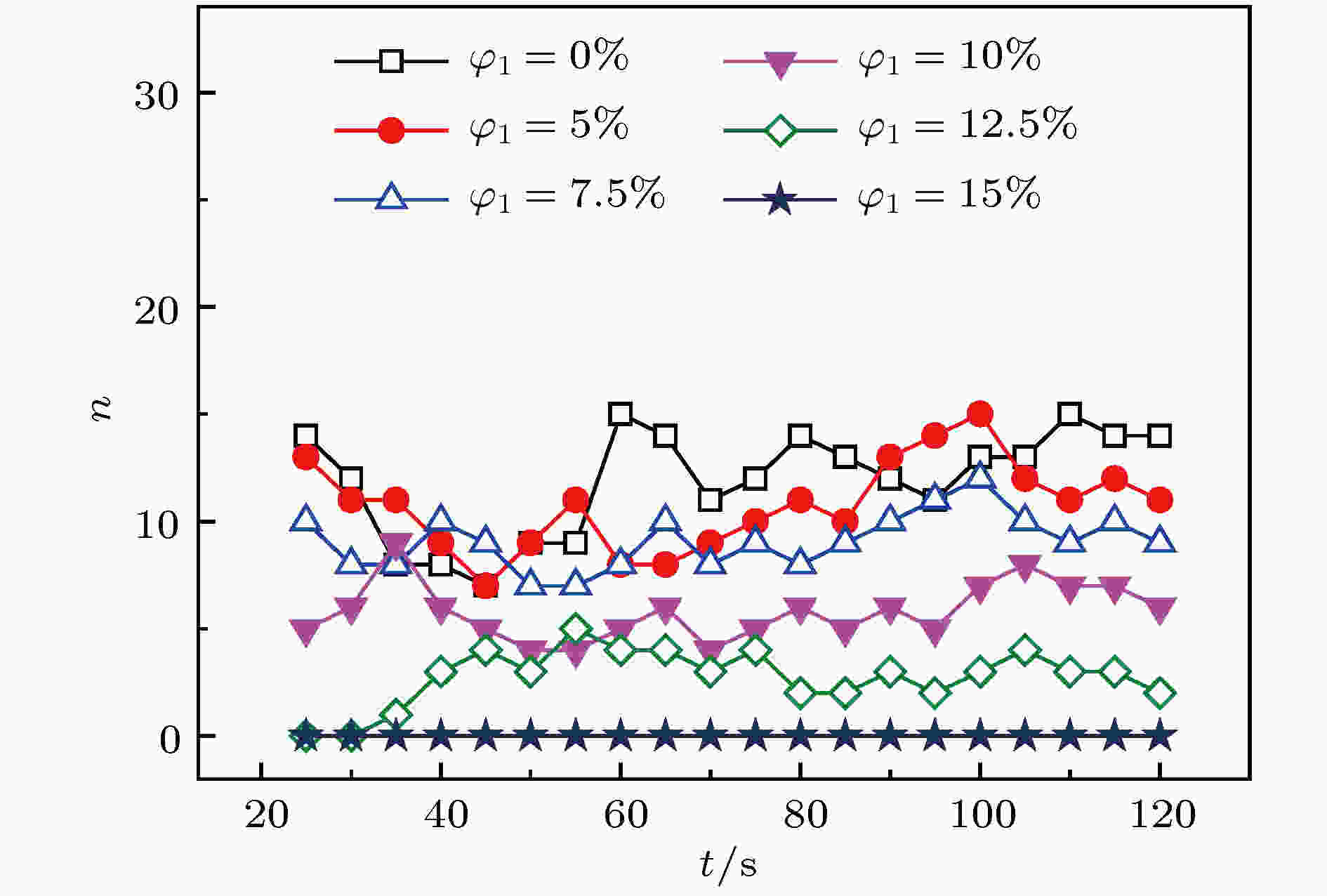 图 19 甲苯相丙酮初始浓度对羽状流数量的影响
图 19 甲苯相丙酮初始浓度对羽状流数量的影响Figure19. The influence of initial concentration of acetone in the toluene phase on the number of the plumes.
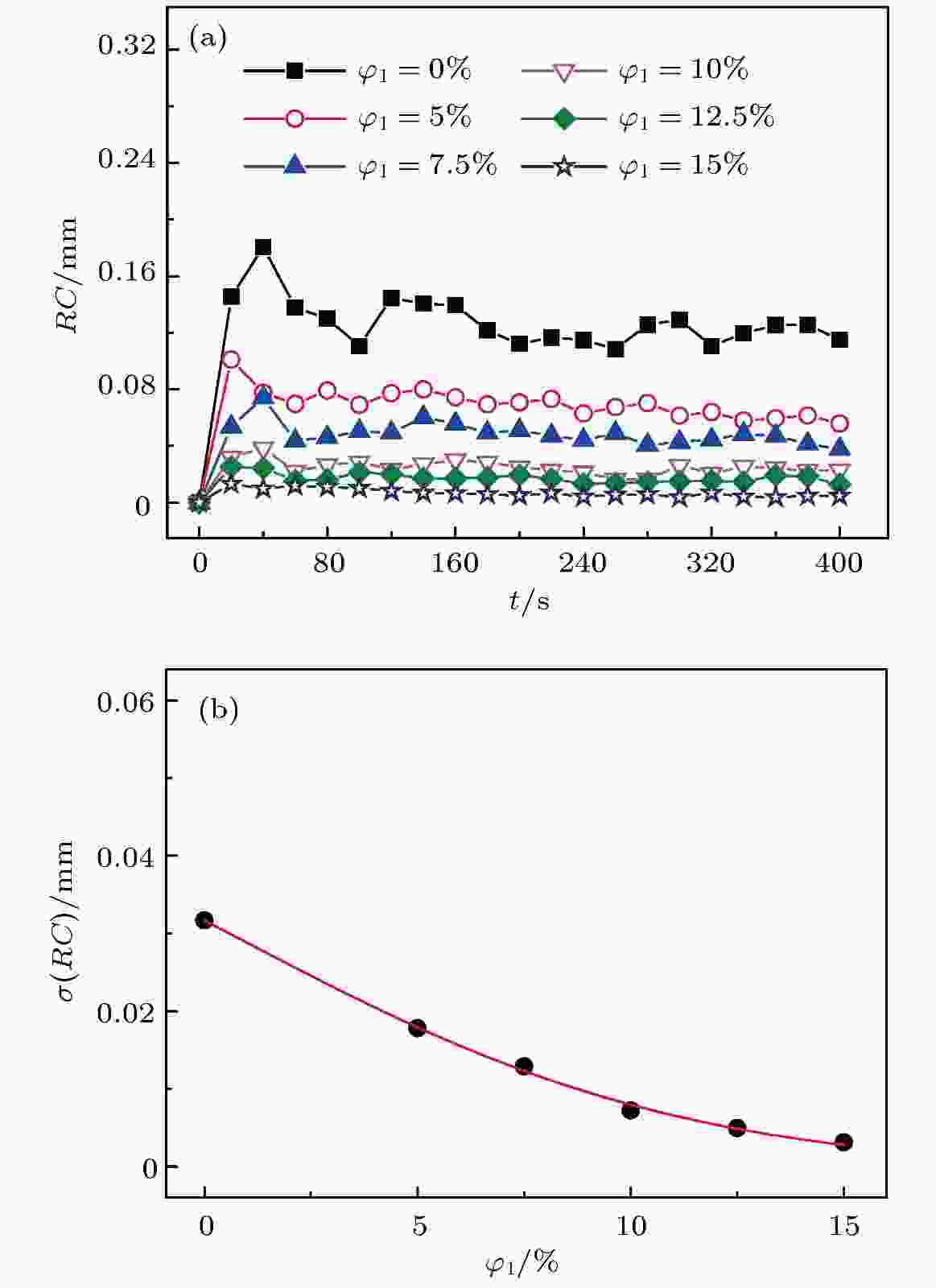 图 20 甲苯相丙酮初始浓度对水-甲苯界面形貌的影响 (a)界面粗糙度; (b)界面波动程度
图 20 甲苯相丙酮初始浓度对水-甲苯界面形貌的影响 (a)界面粗糙度; (b)界面波动程度Figure20. The influence of initial concentration of acetone in the toluene phase on water-toluene interface morphology: (a) Interfacial roughness; (b) the degree of interface fluctuation.
2
3.4.甲苯相液层厚度对RBM对流特性影响
值得注意的是, 由于本实验中上部甲苯液层的体积有限, 因此丙酮向甲苯相的扩散传质将使得甲苯相中的丙酮浓度(分压力)升高, 从而降低水相与甲苯相间的丙酮浓度梯度, 进而影响到RBM对流特性. 为此, 图21和图22分别给出了
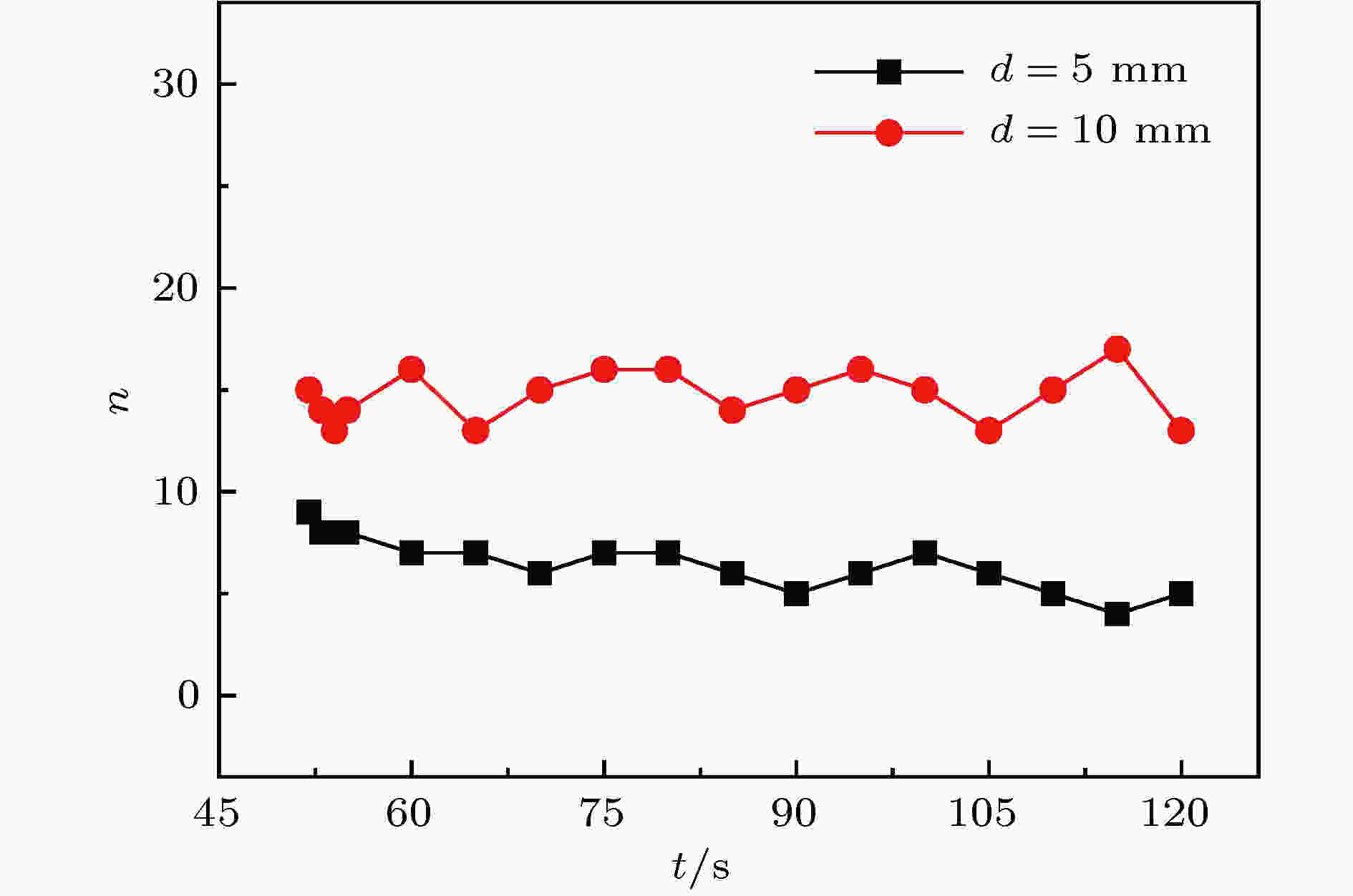 图 21 甲苯层厚度对羽状流数量的影响
图 21 甲苯层厚度对羽状流数量的影响Figure21. The influence of thickness of toluene layer on the number of the plumes.
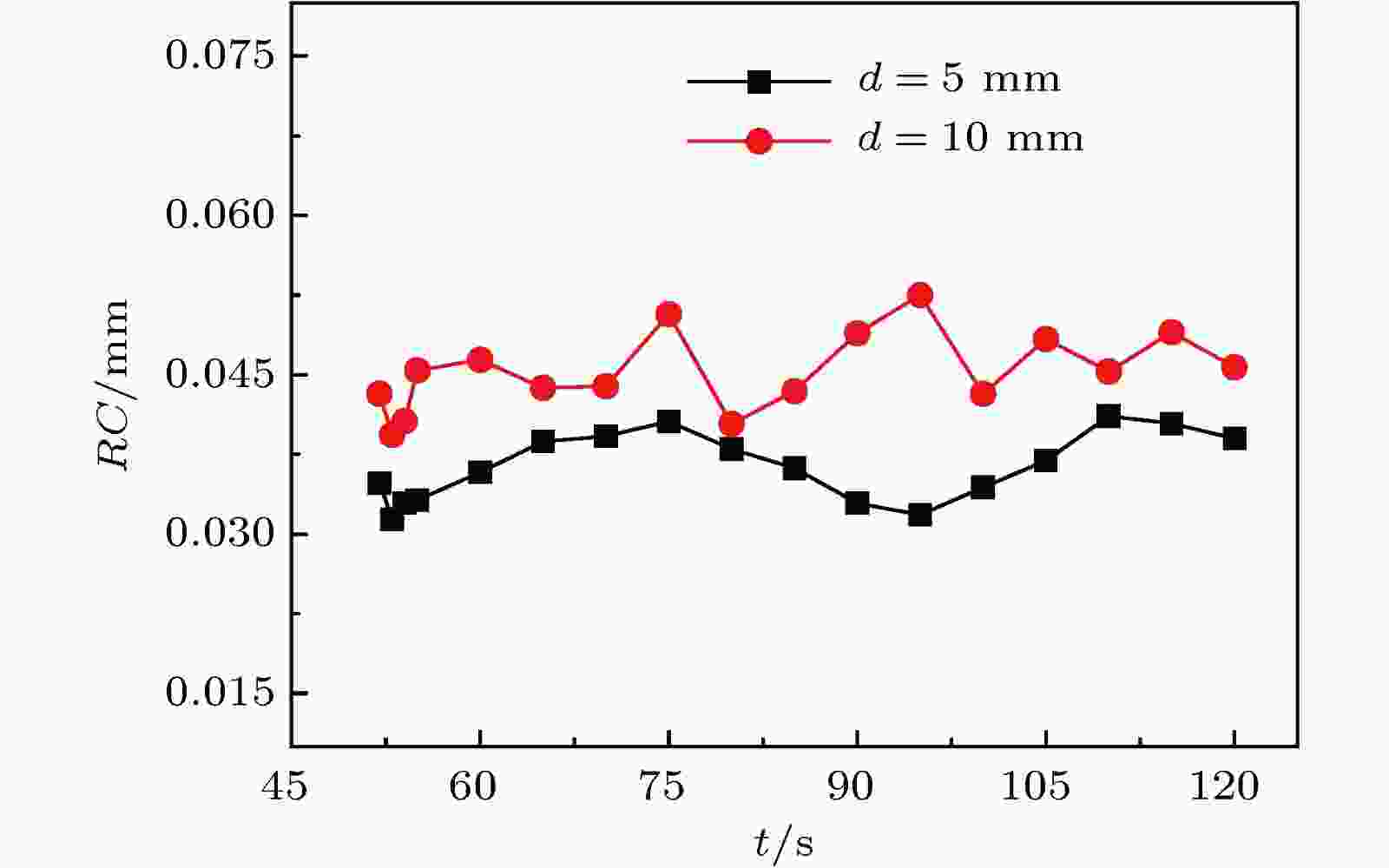 图 22 甲苯层厚度对水-甲苯界面形貌的影响
图 22 甲苯层厚度对水-甲苯界面形貌的影响Figure22. The influence of thickness of toluene layer on water - toluene interface morphology.
由图可知, 在同样的丙酮跨界面扩散传质强度下, 液层厚度大(体积大)的甲苯相中丙酮浓度的上升幅度要小于液层厚度小(体积小)时的上升幅度. 因此, 较厚的甲苯液层能够维持界面内外较大的丙酮浓度差异, 丙酮向上传质的强度更大, 其引发的Rayleigh-Taylor不稳定性和RBM对流现象更加明显. 因此, 当甲苯液膜较厚时, RBM对流羽状流数目较多(见图21), 水-甲苯界面粗糙度较大且其数值波动更为明显(见图22).
1) 丙酮跨液-液界面传质引起近界面处水相流体内的密度(重力)分层和扰动, 造成密度(重力)分层“界面”上产生Rayleigh-Taylor不稳定性, 进而促使密度(重力)分层“界面”下凸沉降形成丘状“界面”, 随着丘状“界面”处密度与压力失调的加剧而演变成羽状流;
2) 因中心羽流区与两侧涡流区所产生的压差挤压作用和下层相对静止流体的阻碍作用, 羽流区由柱状发展成倒蘑菇状, 从而形成强羽状流, 并且随着羽流区与主流区传质过程的进行, 而进一步演化成羽毛状, 形成弱羽状流; 当丙酮浓度梯度增大到一定程度后, 近界面处短时间内产生大量RBM对流结构, 且结构间相互影响增强而聚并成对流团, 并随着传质过程的进行, 逐渐演变成独立的强羽状流;
3) RBM对流强度与上下液层丙酮浓度梯度大小呈正相关关系: 随着界面处丙酮浓度梯度的增大, RMB对流结构延伸速度逐渐加快; 羽状流枝杈数量增多且传质过程中其数值波动变大, 由此近界面处流场扰动增强, 导致不同时刻液-液界面粗糙度相对增大, 且界面粗糙度的数值波动变大.
衷心感谢东南大学能源与环境学院邓梓龙博士在实验系统设计、搭建方面的指导和有益建议.
